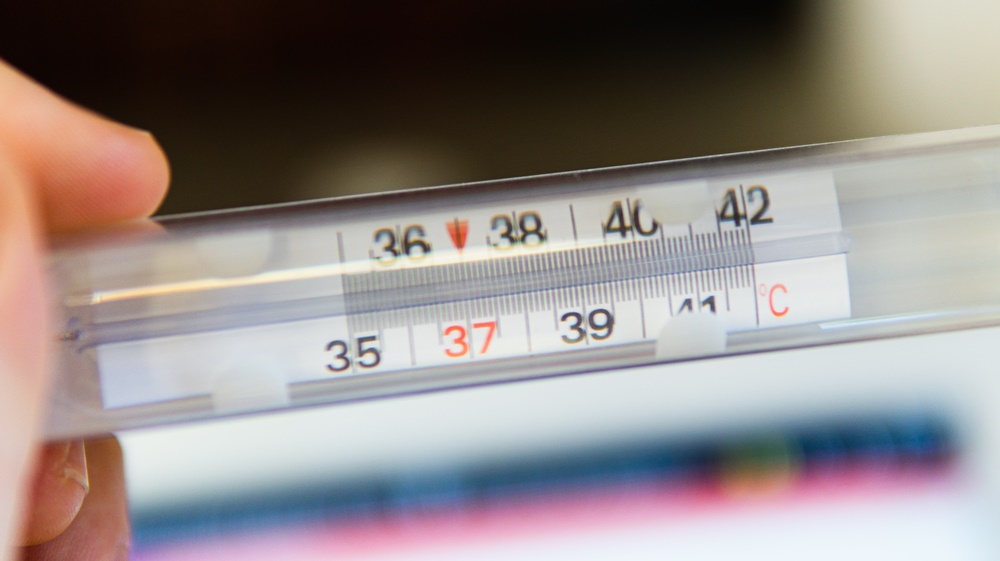Why does fever occur?
A normal body temperature is maintained despite environmental variations, due to the control exerted by the thermoregulatory center in the brain. This thermoregulatory center is located in the hypothalamus. It maintains the body temperature in the range of 36.5–37.5°C (97.7–99.5°F).
Regulation of body temperature
Nerve receptors for sensing warmth and cold are present in the skin. They transmit this sensation to the hypothalamus. Hypothalamus is also capable of sensing the temperature of the circulating blood. Information from both of the above sources is integrated by the thermoregulatory center to maintain a normal body temperature. The main sites of heat production in our body are the liver and skeletal muscles. When the body temperature tends to rise in the hot environment, there is increased heat dissipation from lungs and skin by vasodilatation, evaporation of sweating, and exhalation of air. This is reversed in the opposite situation of a cold environment where body heat is conserved by dermal (related to skin) vasoconstriction and the absence of sweating.
What is fever?
Normally the body temperature is lower in the morning and higher in the evening, as per the metabolic changes. So the fever is defined as body temperature more than 37.2°C (98.9°F) in the morning or higher than 37.7°C (99.9°F) in the evening.
How does fever occur?
Fever is a persistent elevation of body temperature and occurs because the thermostat in the hypothalamus is reset to a higher level. When this occurs, the vasomotor center in the brain (center which controls the degree of constriction or relaxation of blood vessels) is stimulated and causes constriction of blood vessels in the hands and feet. Diversion of blood from the periphery to internal organs reduces heat loss. This results in a feeling of cold which occurs with the onset of fever. This is followed by shivering which occurs due to contraction of muscles, the aim of which is to increase body temperature to the higher reset point of the thermostat. There is also increased heat production in the liver. The patients put on more clothes to reduce heat loss. Once the desired set point is reached, the thermostat maintains that temperature in its usual mechanism.
When the fever subsides due to antipyretics or the disappearance of pyrogens (chemicals or substances that cause fever) after treatment, the thermostat is again reset to normal settings. This results in heat loss by vasodilatation (dilatation of blood vessels in the skin) and sweating. The patient removes the excess clothes and finally the temperature returns to normal.
How is the thermostat reset?
The thermostat in the hypothalamus of the brain is set to the higher point by pyrogens. These pyrogens are either derived from bacteria (endotoxins and exotoxins) or are small proteins called cytokines (interleukin 1 and 6, tumor necrosis factor, interferon-α) produced by monocytes and macrophages (white blood cells). Other than bacteria, fungi, viruses, inflammation, injury, necrosis of tissue, and antigen-antibody complexes can induce the production of pyrogens which trigger the hypothalamus to raise the setpoint to cause fever. It has also been proven that these pyrogens lead to the production of prostaglandin E2 in the hypothalamus and in other parts of the body which finally raises the set point.
Hyperpyrexia
Fever or pyrexia of more than 41.5°C (106.7°F) is defined as hyperpyrexia. This is seen in severe infections and in central nervous system bleeding. Hyperthermia or heat stroke is another situation in which the body temperature is very high. In this condition, the temperature exceeds the capacity of the body to lose heat. Since this raised temperature is not due to pyrogens, the thermostat settings are normal in hyperthermia. It occurs due to exposure to a very hot environment or working in a hot environment e.g. engine room of a ship.
Fever is the body’s response to multiple insults against which the immunity acts to maintain a normal internal environment. The cause may be simple like common cold to a life-threatening condition like meningitis. Any fever should be taken seriously, especially in children and old and a physician consult should be taken.




























